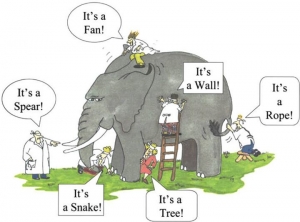Building a Better Elephant
Anatomy of Experience, by Howard Rose
We’re all familiar with the metaphor of the 5 blindfolded people feeling different parts of the elephant and coming to very different conclusions about what’s the what.

Tellers of this road worn parable typically exhort us to remove our blindfolds and take in the whole, not just the bit that’s in front of us. That’s a great message, but it ignores a glaring inconvenient truth.
OK – we take the blinders off to discover the whole elephant! Hooray! Then we unwittingly assume because we know this elephant we know all elephants. Look! Something out on the horizon that looks sort of like an elephant – it must be an elephant too! Time to remove the next blindfold…
In the jargon of Kahneman and Tversky’s cognitive biases, what we have here is anchoring, confirmation, and selection bias, to name a few. According to cognitive bias theory, being human unfortunately means being fairly blind to our own blindfolds.
How about we just admit that, in spite of our best efforts, people are wired to focus on what’s in front of us right now, filtered by what we know and feel about it. Then we construct a story to give that thing or moment meaning.
The stores we build becomes the lens for how we see the rest of the world, and the cycle continues. I’m definitely not saying we’re hopelessly trapped so lets just give up – I’m just saying we could all use some help. If we can’t fully fix ourselves, how about creating a better elephant?
What would a better elephant look like? First of all, I’m thinking of a digital elephant. Our better, digital elephant:
- is built with the understanding that we have blindfolds;
- is aware of me and my tendencies. Better Elephants can change to give me what I need when I need it;
- helps me and my co-pachyderm explorers understand the limits of our view in relation to the whole. Better elephants suggest a view for us that will be useful and expand our vision. They change and flex to make us change and flex;
- offers counter-elephant examples to challenge biases;
- connects me to other elephant gropers. Time to move beyond working in isolation to benefit from shared wisdom.
The Better Elephant suggests a digital design paradigm based in very human strengths and weaknesses. It moves us sensibly past putting the onus on the blindfolded folks to change. The Better Elephant still requires us to strive to see clearly, but it pushes back on designer to solve next order problems.
Reimagining the elephant helps us turn any problem on its head. When we do it, our success will feed on success. As we uncover new solutions we grow more in touch with our own better elephants.
© 2021 Howard Rose, all rights reserved
Discover more from Howard Rose
Subscribe to get the latest posts sent to your email.


